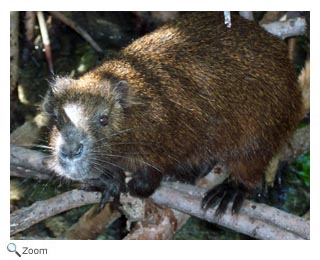Capromyidae - West Indian hutias
 There are around 13 living species and 6 extinct species in this family. They are found in the islands of the Caribbean, especially Cuba. Hutias look like
nutrias. They have stout bodies, large heads, round ears, and short legs. Some species have long tails, others have short or no tails. Some species live in trees and others live on the ground. Most species are herbivores and eat fruit and leaves, but some species also eat invertebrates, and reptiles. There are around 13 living species and 6 extinct species in this family. They are found in the islands of the Caribbean, especially Cuba. Hutias look like
nutrias. They have stout bodies, large heads, round ears, and short legs. Some species have long tails, others have short or no tails. Some species live in trees and others live on the ground. Most species are herbivores and eat fruit and leaves, but some species also eat invertebrates, and reptiles.
World Status Key
 Least Concern Least Concern  Near Threatened Near Threatened  Vulnerable Vulnerable  Endangered Endangered  Critically Endangered Critically Endangered  Extinct in the Wild Extinct in the Wild
 Extinct Extinct
Status and range is taken from ICUN Redlist. If no status is listed, there is not enough data to establish status.
US Status Key
 Threatened in US Threatened in US  Threatened in NH Threatened in NH  Endangered in US Endangered in US  Endangered in NH Endangered in NH
 Breeds in NH Breeds in NH  Introduced Introduced
Status taken from US Fish and Wildlife and NH Fish and Game
Additional Information
Key:  Profile Profile  Photos Photos  Video Video  Audio Audio
Desmarest's Hutia - Capromys pilorides    
Desmarest's hutia is found in Cuba.
Source: Animal Diversity Web Intended Audience: General Reading Level: Middle /High School
Desmarest's Hutia - Capromys pilorides    
Desmarest’s hutia is the largest of the hutia species.
Source: World Association of Zoos and Aquariums Intended Audience: General Reading Level: Middle /High School
Dwarf Hutia - Mesocapromys nanus    
The dwarf hutia was last seen in 1937, but droppings and tracks have been found since then. It is found in the Matanzas Province in Cuba.
Source: EDGE Intended Audience: General Reading Level: Middle School
Little Earth Hutia - Mesocapromys sanfelipensis    
The little Earth hutia was last seen in 1978. It is found on the Archipiélago de los Canorreos in the Pinar del Rio Province in Cuba.
Source: EDGE Intended Audience: General Reading Level: Middle School
Hispaniolan Hutia - Plagiodontia aedium     
The Hispaniolan hutia is also known as Cuvier's hutia. It is found in the Dominican Republic and Haiti.
Source: Arkive Intended Audience: General Reading Level: Middle School
Ingraham's Hutia - Geocapromys ingrahami   
Ingraham's hutia is also known as the Bahamian hutia. It is found ion the islands of the Bahamas.
Source: Animal Diversity Web Intended Audience: General Reading Level: Middle /High School Jamaican Hutia - Geocapromys brownii   
The Jamaican hutia is only found in Jamaica.
Source: Arkive Intended Audience: General Reading Level: Middle School
Jamaican Hutia - Geocapromys brownii    
The Jamaican hutia is also known as Brown's hutia.
Source: Animal Diversity Web Intended Audience: General Reading Level: Middle /High School
Prehensile-tailed Hutia - Mysateles prehensilis    
The prehensile-tailed hutia is found in Cuba.
Source: Animal Diversity Web Intended Audience: General Reading Level: Middle /High School
Puerto Rican Hutia - Isolobodon portoricensis    
The Puerto Rican hutia was once found in Haiti and Dominican Republic and offshore islands. It was introduced to Puerto Rico, Saint Thomas, Saint Croix, and Mona Islands. It has probably been extinct since 1525.
Source: EDGE Intended Audience: General Reading Level: Middle /High School |

